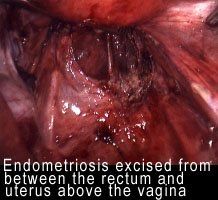Treatment of Endometriosis
Currently there are two ways to treat endometriosis – hormonal therapy and surgery. Depending on the patient’s expectations and the extent of the disease, we may prescribe hormonal therapy, surgery, a combination of surgery and hormonal therapy, or occasionally a just “wait and see” approach.
What is Endometriosis? What Causes Endometriosis? Symptoms of Endometriosis Diagnosis of Endometriosis Current Treatment of Endometriosis
Treatment of Endometriosis
Currently there are two ways to treat endometriosis – hormonal therapy and surgery.
Depending on the patient’s expectations and the extent of the disease, we may prescribe hormonal therapy, surgery, a combination of surgery and hormonal therapy, or occasionally a just “wait and see” approach.
Hormonal Therapy
Hormonal therapy is based on the knowledge of the response of existing estrogen and progesterone receptors on ectopic endometrial tissue to certain hormonal agents. Since endometrial lesions are not all the same with regard to the number and response of receptors to the hormonal agents, the result of the hormonal treatment may vary from patient to patient. Hormonal therapy is considered as suppressive, thus temporary. Endometriosis will recur after the treatment is discontinued. Following are some of the currently available hormonal agents for treatment of endometriosis.
- Birth Control Pills: Birth control pills, or oral contraceptives, are the combination of estrogen and progestin pills to regulate a patient’s hormonal levels and suppress endometrial growth. While a patient is on birth control pills, ovulation usually ceases and endometrial lesions shrink. The common side effects of taking birth control pills are weight gain, nausea, headache, mood changes, depression, irregular vaginal bleeding, and loss of sexual desire.
- GnRH Agonists: This agent works by suppressing the pituitary hormones (FSH and LH) to stop the ovary from producing estrogen, putting the patient into a menopausal state, and thus shrinking the endometrial lesions. The names of GnRH agonists include Lupron Depot, Synarel, and Zoladex. The drug can be given by injection or nasal spray. The main side effects of menopausal syndromes are hot flashes, cold sweat, insomnia, vaginal dryness, loss of sexual interest, and depression. The FDA has approved GnRH agonists for no longer than six months in a lifetime due to the risk of osteoporosis.
- Progestins: Progestins work by keeping the ovarian hormone (estrogen and progesterone) levels low to prevent ovulation and suppress endometrial growth. Common names of progestins are Provera, Cycrine, Megace, Micronor, Amen, Nor-Q.D., and Depo-Provera. The main side effects include irregular vaginal bleeding, depression, breast tenderness, moodiness, weight gain, headache, and fluid retention.
- Danazol: Danazol exhibit some androgen (male hormone) effect and reduces ovarian hormonal production. Most women will stop ovulation and menstruation when they are on Danazol, and their endometrial lesions will shrink and become inactive. The main side effects of Danazol are weight gain, decrease in breast size, acne, oily skin, male-pattern hair growth, and deepening of the voice.
Surgical Treatment
Laparoscopic surgery is the main and definite way to diagnose and treat endometriosis. Ideally, all the endometrial lesions should be excised through the laparoscope at the initial diagnosis of endometriosis. Unfortunately, most gynecologists are not well trained in treating extensive endometriosis through laparoscopy. Thus many women with extensive endometriosis often require more than one surgery and suffer from many undesirable sequelae of poorly performed surgery. It can not be emphasized more the importance of finding a well trained gynecologist at initial diagnosis and treatment of endometriosis.

The definite treatment of endometriosis is NOT hysterectomy and bilateral salpingo-oophorectomy (remove both uterus and ovaries) – Many gynecologists now a days still mistakenly believe that remove both uterus and ovaries are the cure for endometriosis. In our center we believe strongly that the correct way of treating endometriosis is the complete excision of the endometrial lesions, whether it appears on the pelvic organs or on the bowel, ureter (draining tube between the kidney and the bladder), and bladder.
The decision of whether to perform hysterectomy or oophorectomy at time of endometriosis surgery will purely based on whether there are any coexisting uterine or ovarian pathology in addition to the presence of endometriosis and patient’s desire for future childbearing. For example, if patient is known to have severe endometriosis and no longer desires to bear a child, and meanwhile fibroids (benign tumor of womb which may cause heavy menstrual bleeding and cramps) are found on her uterus, then hysterectomy along with excision of all endometriosis should be recommended for patient. Throughout years,we have performed numerous laparoscopic surgeries for extensive endometriosis with excellent results without removing either normal uterus or ovaries.
The Role of Presacral Neurectomy in Conservative Surgical Treatment for Endometriosis
We sometimes perform Presacral Neurectomy (resection of part of presacral nerve which is in charge of pain sensation in the midline pelvic area. The procedure will reduce the pain and cramps in the midpelvic area and it does not affect the sexual feeling or sensation of the patient) along with the excision of endometrial implants for those patients desire to have future childbearing but suffer from severe midline pelvic pain and cramps.
Recap on reproductive rights with David Hackney, MD, MS
December 20th 2022In this episode of Pap Talk, we spoke with David Hackney, MD, MS, maternal-fetal medicine physician at Case Western Reserve University and chair of ACOG's Ohio chapter for a full recap of where restrictions on reproductive rights have been and where they're going.
Listen
In this episode of Pap Talk, Gloria Bachmann, MD, MSc, breaks down what it means to be a health care provider for incarcerated individuals, and explores the specific challenges women and their providers face during and after incarceration. Joined by sexual health expert Michael Krychman, MD, Bachmann also discusses trauma-informed care and how providers can get informed.
Listen
